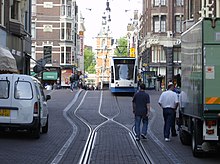
Back حضرية جديدة Arabic Новы урбанізм BE Nový urbanismus Czech New Urbanism Danish New Urbanism German Νέα αστικοποίηση Greek Nuevo urbanismo Spanish Uus-urbanism ET نوشهرگرایی FA Uusi urbanismi Finnish

New Urbanism is an urban design movement that promotes environmentally friendly habits by creating walkable neighbourhoods containing a wide range of housing and job types. It arose in the United States in the early 1980s, and has gradually influenced many aspects of real estate development, urban planning, and municipal land-use strategies. New Urbanism attempts to address the ills associated with urban sprawl and post-WW II suburban development.
New Urbanism is strongly influenced by urban design practices that were prominent until the rise of the automobile prior to World War II; it encompasses basic principles such as traditional neighborhood development (TND) and transit-oriented development (TOD).[1] These concrete principles emerge from two organizing concepts or goals: building a sense of community and the development of ecological practices.[2]
New Urbanists support regional planning for open space; context-appropriate architecture and planning; adequate provision of infrastructure such as sporting facilities, libraries and community centres;[3] and the balanced development of jobs and housing. They believe their strategies can reduce traffic congestion by encouraging the population to ride bikes, walk, or take the train. They also hope to increase the supply of affordable housing and rein in suburban sprawl. The Charter of the New Urbanism also covers issues such as historic preservation, safe streets, green building, and the redevelopment of brownfield land.[4] The ten Principles of Intelligent Urbanism also phrase guidelines for New Urbanist approaches.
Architecturally, New Urbanist developments are often accompanied by New Classical, postmodern, or vernacular styles, although that is not always the case. The movement's principles are reflected in the field of Complementary architecture.
- ^ Kelbaugh, Douglas S. 2002. Repairing the American Metropolis: Common Place Revisited. Seattle: University of Washington Press. 161.
- ^ "Urbanism Principles". www.newurbanism.org. Retrieved 20 January 2016.
- ^ Wear, Andrew (16 February 2016). "Planning, Funding and Delivering Social Infrastructure in Australia's Outer Suburban Growth Areas". Urban Policy and Research. 34 (3): 284–297. doi:10.1080/08111146.2015.1099523. S2CID 155633165.
- ^ Talen, Emily (2002). "The social goals of new urbanism". Housing Policy Debate. 13 (1): 165–188. doi:10.1080/10511482.2002.9521438. S2CID 145521120.
